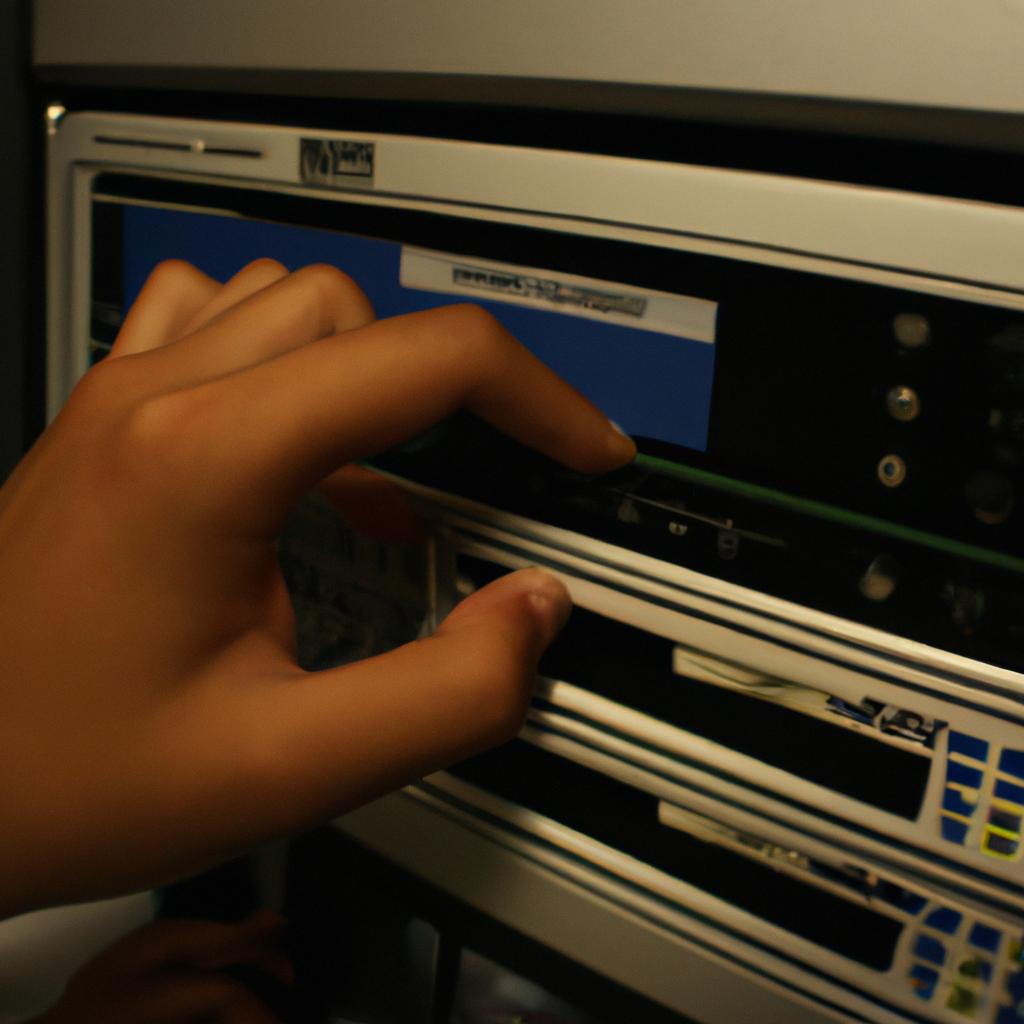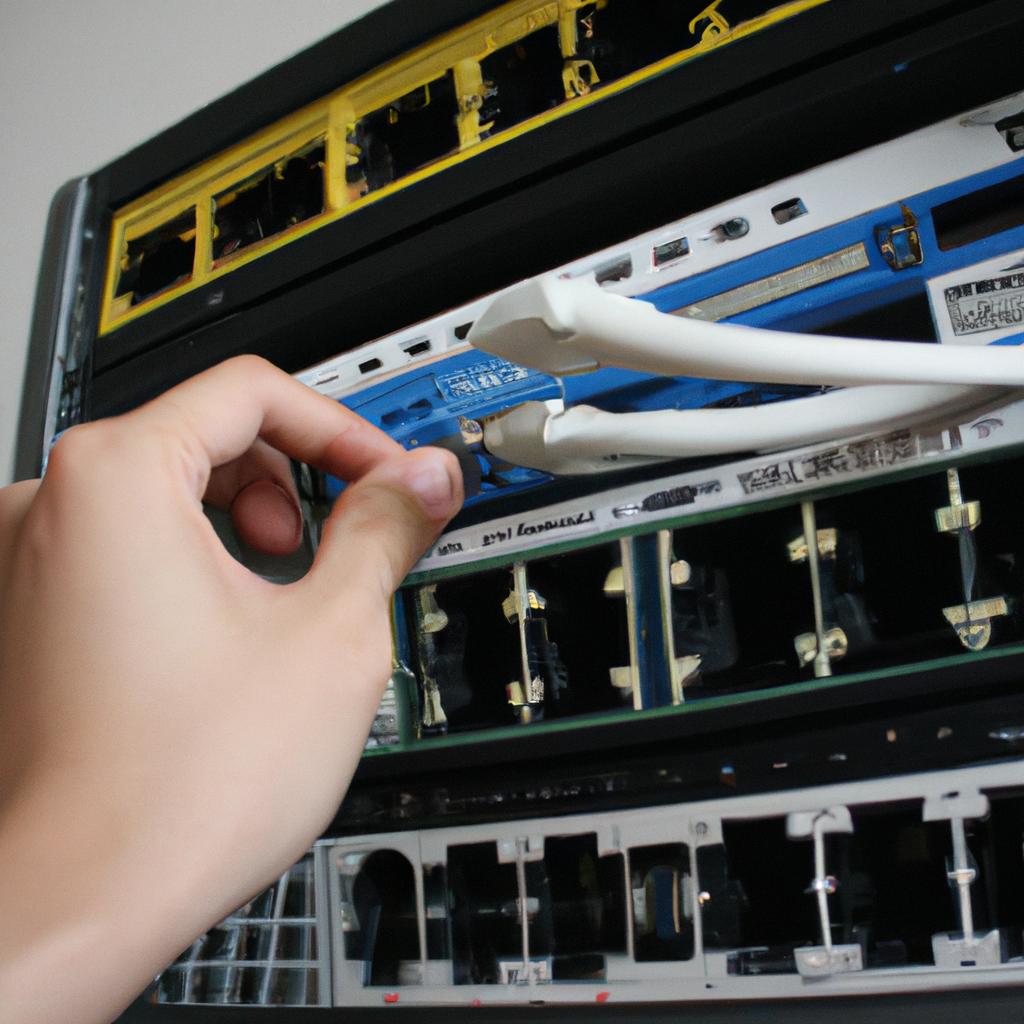Access control plays a critical role in enhancing web server security by providing mechanisms to restrict unauthorized access and protect sensitive information. In today’s digital landscape, where cyber attacks are becoming increasingly sophisticated, implementing effective access control measures is essential for organizations to safeguard their systems and data. For instance, consider the case of a multinational corporation that experienced a significant data breach due to inadequate access controls on its web servers. This incident resulted in the exposure of highly confidential customer information and financial records, leading to severe reputational damage and substantial monetary losses. Such incidents highlight the importance of robust access control solutions in mitigating security risks associated with web servers.
Web server security encompasses various aspects such as authentication, authorization, and auditing processes that collectively contribute to an organization’s overall security posture. Authentication ensures only legitimate users can gain access to the web server by verifying their identities through credentials or multifactor authentication methods. Authorization grants appropriate privileges based on user roles and permissions, allowing them access only to specific resources necessary for their tasks while restricting unnecessary privileges that could potentially be exploited. Additionally, auditing tracks and monitors all activities within the web server environment, enabling administrators to identify suspicious behavior or potential security breaches promptly.
In this article, we will delve into the significance of access control in enhancing web server security and explore various access control mechanisms that organizations can implement to protect their web servers from unauthorized access.
Access control is crucial for web server security as it allows organizations to establish a layered defense system, ensuring that only authorized individuals or entities can access sensitive resources. By implementing strong access control measures, organizations can minimize the risk of unauthorized disclosure, alteration, or destruction of valuable data residing on their web servers.
One commonly used access control mechanism is role-based access control (RBAC), which assigns specific roles to users based on their job responsibilities. RBAC ensures that users have the necessary privileges and permissions required to perform their tasks effectively while preventing them from accessing resources beyond their scope. This reduces the potential for insider threats and limits the damage caused by compromised user accounts.
Another important aspect of access control is the implementation of strong authentication mechanisms. This includes requiring users to provide unique credentials such as usernames and passwords, along with additional factors like biometrics or hardware tokens for multifactor authentication. Strong authentication helps prevent unauthorized individuals from gaining access even if they manage to obtain someone’s login credentials.
Organizations should also consider implementing granular authorization controls to restrict access at a more detailed level. This involves defining specific permissions for individual resources or groups of resources within the web server environment. By granting privileges on a need-to-know basis, organizations can ensure that only authorized users can view, modify, or delete sensitive data stored on the web server.
Regular auditing and monitoring are also critical components of robust access control systems. Auditing enables administrators to track user activities, detect suspicious behavior, and investigate potential security incidents promptly. By analyzing audit logs and conducting regular security assessments, organizations can identify vulnerabilities in their access control mechanisms and take appropriate measures to address them proactively.
In conclusion, effective access control plays a vital role in enhancing web server security by preventing unauthorized access and protecting sensitive information from being compromised. Organizations must implement strong authentication mechanisms, enforce granular authorization controls, and establish regular auditing practices to mitigate security risks associated with web servers. By prioritizing access control measures, organizations can safeguard their systems and data from cyber threats, ensuring the confidentiality, integrity, and availability of their web server resources.
Types of Access Control
Access control is a crucial aspect of web server security that aims to regulate and manage user permissions within an information system. By implementing effective access control mechanisms, organizations can protect sensitive data from unauthorized access, ensuring the confidentiality, integrity, and availability of their resources. This section will explore various types of access control methods commonly used in web servers.
Case Study:
To illustrate the importance of access control, consider a hypothetical scenario where a healthcare organization stores patient records on its web server. Without proper access controls in place, any user would have unrestricted access to these confidential files, potentially leading to breaches of privacy or even identity theft. To prevent such risks and maintain compliance with regulatory standards (e.g., HIPAA), robust access controls are imperative.
Effective access control measures provide several benefits for organizations:
- Enhanced security by restricting unauthorized users’ ability to view or modify sensitive information.
- Improved accountability as actions performed by each user can be traced back to their unique identifiers.
- Reduced risk of insider threats through granular permission assignment based on roles and responsibilities.
- Increased productivity by enabling efficient collaboration while still maintaining necessary restrictions.
| Types of Access Control | Description |
|---|---|
| Discretionary Access Control (DAC) | Users have explicit control over objects they own and can assign permissions to other users. |
| Mandatory Access Control (MAC) | Permissions are assigned based on predefined security policies determined by administrators or system owners. |
| Role-Based Access Control (RBAC) | Assigns permissions based on predefined roles within an organization, allowing for easier management and scalability. |
| Attribute-Based Access Control (ABAC) | Access decisions are made using attributes associated with both subjects and objects, providing more fine-grained control over permissions. |
In conclusion, implementing appropriate access control mechanisms is vital for safeguarding web servers against potential cyber threats. By adopting effective access control measures, organizations can ensure the confidentiality of sensitive information, maintain accountability, reduce insider risks, and improve overall productivity. The next section will discuss common vulnerabilities found in web servers and highlight the importance of addressing these issues to enhance security further.
Common Vulnerabilities in Web Servers
Access Control: Enhancing Web Server Security
Types of Access Control play a crucial role in enhancing the security of web servers. By implementing effective access control mechanisms, organizations can safeguard sensitive information and prevent unauthorized access to their systems. In this section, we will explore some common vulnerabilities that web servers face and how access control measures can mitigate these risks.
Imagine a scenario where an organization’s web server is compromised due to weak access controls. This breach allows an attacker to gain unauthorized access to confidential customer data, resulting in significant financial losses and reputational damage. Such incidents highlight the importance of robust access control mechanisms in securing web servers.
To ensure comprehensive protection against potential threats, organizations should consider the following key aspects when implementing access control for their web servers:
- Authentication: Implementing strong authentication methods such as multi-factor authentication or biometric verification adds an extra layer of security by verifying users’ identities before granting them access.
- Authorization: Clearly defining user roles and permissions helps restrict privileges only to authorized individuals, reducing the risk of unauthorized actions or data breaches.
- Auditing and Monitoring: Regularly monitoring system logs and conducting audits enable organizations to detect any suspicious activities or policy violations promptly. This proactive approach enhances threat detection capabilities and facilitates timely response measures.
- Continuous Updates and Patch Management: Ensuring that all software components are up-to-date with the latest security patches is vital in mitigating known vulnerabilities that could be exploited by attackers.
Table 1 below illustrates some common vulnerabilities faced by web servers alongside corresponding mitigation strategies using access control techniques:
| Vulnerability | Mitigation Strategy |
|---|---|
| Weak Passwords | Enforce password complexity requirements |
| Unrestricted File Uploads | Implement file type validation |
| SQL Injection Attacks | Utilize parameterized queries |
| Cross-Site Scripting (XSS) | Employ input sanitization techniques |
Implementing Role-Based Access Control (RBAC) is an effective approach to enhance web server security. By assigning permissions based on predefined roles, RBAC reduces administrative overhead and minimizes the risk of human error in access control management processes.
Transitioning seamlessly from access control vulnerabilities, let us now discuss how organizations can implement Role-Based Access Control to fortify their web servers against potential threats.
Implementing Role-Based Access Control
Enhancing Web Server Security through Role-Based Access Control
In the previous section, we explored some common vulnerabilities that web servers can be susceptible to. Now, let us delve into one effective solution for mitigating these risks: implementing role-based access control (RBAC). RBAC is a security measure that assigns users specific roles and permissions based on their responsibilities within an organization. By utilizing RBAC, organizations can establish a more robust access control framework, reducing the likelihood of unauthorized access and potential security breaches.
To illustrate the effectiveness of RBAC, consider the following hypothetical scenario: Company XYZ operates an e-commerce website that handles sensitive customer information such as payment details. Without proper access controls in place, any employee within the organization could potentially gain unrestricted access to this data. However, by implementing RBAC, different user roles are established with varying levels of privileges. For instance:
- Administrators have full control over the web server and its resources.
- Developers have permission to modify code but cannot make changes to production environments.
- Customer support representatives have read-only access to customer records.
By assigning appropriate roles and permissions to each user based on their job requirements, RBAC helps ensure that only authorized individuals can perform specific actions or view certain data within the system. This proactive approach significantly minimizes the risk of unauthorized activities and protects valuable assets from misuse.
The benefits of implementing RBAC extend beyond improved security measures alone. Let’s take a look at how organizations leveraging this approach experience enhanced operational efficiency:
| Benefits | Description |
|---|---|
| Increased productivity | With clearly defined roles and responsibilities, employees can focus on tasks aligned with their expertise. |
| Streamlined processes | RBAC eliminates unnecessary administrative overhead by automating user provisioning and permission management. |
| Improved auditability | The detailed assignment of roles simplifies tracking and auditing activities, aiding compliance efforts. |
| Enhanced accountability | RBAC ensures that individuals are accountable for their actions, as all activities can be traced back to specific roles. |
In conclusion, implementing role-based access control is an effective strategy for enhancing web server security. By assigning users specific roles and permissions based on their responsibilities, organizations create a more robust access control framework. This approach not only reduces the risk of unauthorized access but also improves operational efficiency through increased productivity, streamlined processes, improved auditability, and enhanced accountability.
Next, let us explore best practices for configuring access controls in order to maximize the effectiveness of RBAC within your organization’s web server environment.
Best Practices for Access Control Configuration
Case Study:
Imagine a scenario where an e-commerce website implemented role-based access control to secure its web server. The system granted different privileges based on the roles assigned to each user, ensuring that only authorized individuals could perform certain actions. However, despite this implementation, the website fell victim to a data breach due to improper configuration of their access control settings.
To prevent similar incidents and enhance web server security, it is crucial to avoid common mistakes when configuring access controls. Consider the following points:
-
Insufficient Validation: Failing to validate inputs from users can lead to vulnerabilities such as injection attacks or privilege escalation. By validating and sanitizing any input received from users, organizations can mitigate potential risks associated with unauthorized access attempts.
-
Overly Permissive Settings: Granting excessive permissions or using overly permissive rules can compromise the integrity and confidentiality of sensitive information. It is essential to carefully evaluate and restrict privileges according to the principle of least privilege (POLP), granting users only the minimum level of access required for their specific tasks.
-
Misconfigured Access Policies: Inaccurate or inconsistent access policies are another prevalent mistake that can undermine web server security efforts. Organizations should ensure that access policies align with business requirements and follow industry best practices, regularly reviewing and updating them as necessary.
-
Lack of Logging and Monitoring: Neglecting proper logging and monitoring mechanisms makes it difficult to detect suspicious activities or track changes made within the system’s access control settings. Implementing robust auditing measures allows for timely identification of any anomalies or unauthorized modifications.
The table below illustrates how these common mistakes impact web server security:
| Common Mistake | Impact |
|---|---|
| Insufficient Validation | Allows attackers to exploit vulnerabilities |
| Overly Permissive Settings | Increases risk of unauthorized activities |
| Misconfigured Access Policies | Compromises consistency and accuracy |
| Lack of Logging and Monitoring | Hinders detection of unauthorized changes |
By avoiding these common mistakes, organizations can significantly enhance the security posture of their web servers. In the subsequent section, we will explore the role of access control in web application firewalls, further strengthening our understanding of safeguarding critical assets from potential threats.
Access Control in Web Application Firewalls
Access control is a critical aspect of web server security, as it helps ensure that only authorized individuals or systems can access the resources and data on a website. In this section, we will explore the importance of access control in enhancing web server security and discuss some best practices for its configuration.
One example that highlights the significance of access control involves an e-commerce platform that experienced a data breach due to weak access control measures. The company failed to properly configure permissions and user roles, allowing unauthorized users to gain unrestricted access to confidential customer information. As a result, sensitive data such as credit card details were compromised, causing significant damage to both the affected customers and the company’s reputation.
To prevent such incidents, it is essential to follow best practices when configuring access control. Here are some key recommendations:
- Implement least privilege: Grant users the minimum level of privileges required to perform their tasks effectively. This approach ensures that even if one account gets compromised, the potential damage is limited.
- Regularly review permissions: Conduct periodic audits to evaluate user permissions and remove unnecessary privileges. This practice helps minimize the risk of unauthorized access due to overlooked or forgotten permissions assigned to users over time.
- Enforce strong authentication mechanisms: Implement multi-factor authentication (MFA) whenever possible to add an extra layer of security. MFA requires users to provide multiple forms of identification before gaining access, significantly reducing the likelihood of unauthorized entry.
- Monitor and log access attempts: Keep detailed logs of all login attempts and regularly analyze them for suspicious activities or patterns. Monitoring access logs enables prompt detection and response to potential security breaches.
In addition to these best practices, organizations should also consider investing in advanced technologies such as web application firewalls (WAFs). These solutions act as a barrier between web servers and incoming traffic, filtering out malicious requests and protecting against common attack vectors like SQL injection and cross-site scripting.
As we move forward into exploring emerging technologies for web server security, it is crucial to remember that access control remains a fundamental aspect of protecting web servers and the sensitive data they hold. By following best practices and leveraging advanced solutions like WAFs, organizations can enhance their overall security posture and better defend against evolving threats.
Next section: ‘Emerging Technologies for Web Server Security’
Emerging Technologies for Web Server Security
Access Control: Enhancing Web Server Security
Transitioning from the previous section discussing access control in web application firewalls, we now turn our attention to emerging technologies for web server security. With cyber threats becoming increasingly sophisticated, it is crucial for organizations to adopt robust measures that safeguard their web servers and protect sensitive data.
To illustrate the importance of enhancing web server security, let us consider a hypothetical scenario. Imagine an e-commerce website that experiences a breach due to inadequate access controls on its server. Cybercriminals exploit this vulnerability and gain unauthorized access to customer information, including credit card details and personal data. This incident not only results in financial losses but also severely damages the trust between the customers and the organization. It highlights the critical need for effective access control mechanisms on web servers.
In order to address these challenges, organizations can implement the following strategies:
- Implement strong authentication methods: By utilizing multi-factor authentication techniques, such as combining passwords with biometric data or hardware tokens, organizations can significantly reduce the risk of unauthorized access.
- Employ role-based access control (RBAC): RBAC allows administrators to assign specific roles and permissions to users based on their responsibilities within an organization. This ensures that individuals have access only to necessary resources, minimizing potential vulnerabilities.
- Regularly update and patch software: Keeping all software up-to-date helps ensure that known vulnerabilities are addressed promptly. By regularly applying patches and updates provided by software vendors, organizations can mitigate risks associated with outdated software versions.
- Conduct regular security audits: Periodic assessments of web server security help identify any weaknesses or gaps in existing controls. These audits enable organizations to take proactive measures towards strengthening their overall security posture.
Table 1 below summarizes key considerations when implementing enhanced access control mechanisms on web servers:
| Key Considerations | Benefits | Challenges |
|---|---|---|
| Strong authentication methods | Mitigates risk of unauthorized access | Increased complexity for users |
| Role-based access control (RBAC) | Granular control over user permissions | Requires careful role assignment |
| Regular software updates and patch management | Addresses known vulnerabilities | Disruption to service during update |
| Regular security audits | Identifies weaknesses in security | Resource-intensive process |
In conclusion, enhancing web server security through effective access control mechanisms is critical in safeguarding sensitive information and protecting against cyber threats. By implementing strong authentication methods, employing RBAC, regularly updating software, and conducting security audits, organizations can significantly reduce the risk of unauthorized access and potential data breaches. It is imperative that organizations prioritize these measures to ensure the integrity and confidentiality of their web servers.










